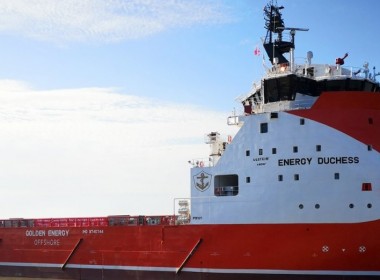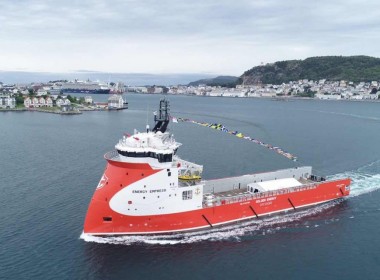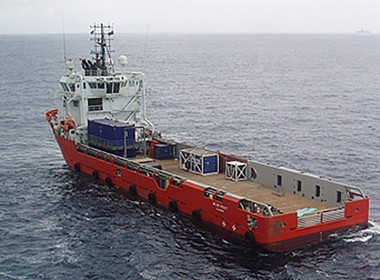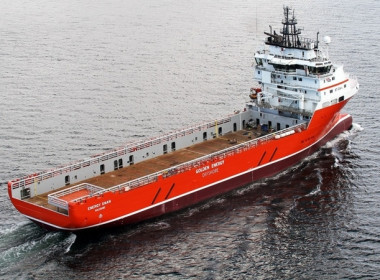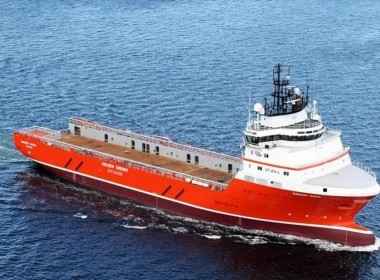COLUMN | Vroon, Vroon, Vroon: Britoil’s take-over marks closure, as Golden Energy flip shows ING’s folly [Offshore Accounts]

Finally, Singapore-headquartered Britoil announced last week that it had completed the purchase of most of the offshore fleet of Vroon, the Dutch ship-owner.
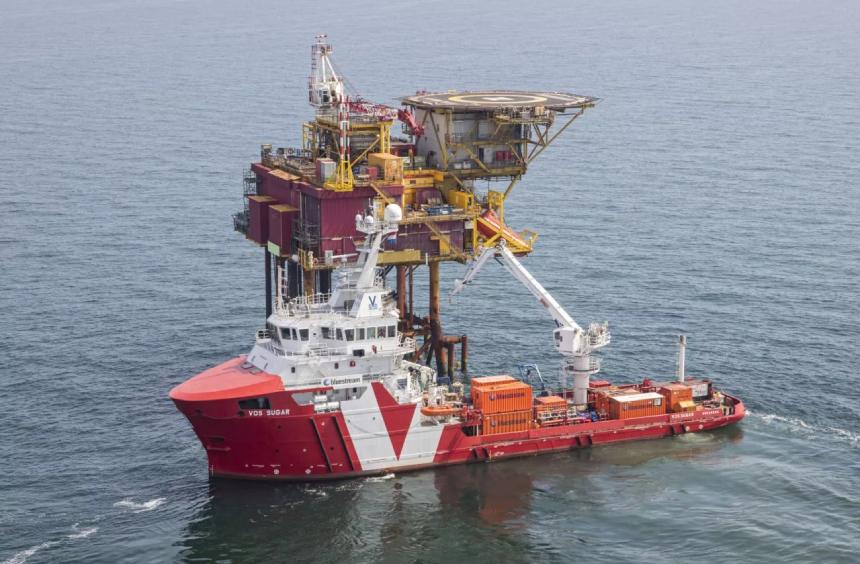
Britoil bought 29 offshore support vessels, plus a small oil spill response vessel from Vroon. Golden Energy Offshore had announced in August that it was buying four large PX121 design platform supply vessels (PSVs) and the small subsea vessel VOS Sugar for US$94 million en bloc. It turns out that two North Sea seismic support vessels in the Vroon fleet will be sold to Dutch seismic supply and chase boat operator Rederij Groen (existing fleet details here). Finally, Vroon’s two walk-to-work vessels VOS Start and VOS Stone, which are fitted with active heave compensated (AHC) gangways and 50-tonne AHC cranes and with accommodations for 87 personnel on board, will be sold privately in a side deal by their lenders.
The sale has been eight months in the making. Vroon announced in January that a group of banks had taken control of the company in a debt-for-equity swap, reducing its group debt from US$1.1 billion to just US$400 million. The banks announced that Vroon’s safety standby vessels, livestock carriers, and bitumen tankers were the core of “New Vroon” and would be retained, but that the fleet of what became apparent as 39 offshore support vessels (not forty as advertised at the start of the process) was surplus to requirements and would be sold. At the same time, Vroon’s CEO Herman Marks stepped down, and the company began a hunt for a buyer for the whole offshore business, apparently attracting over a hundred expressions of interest for all or part of the fleet.
This eight-month time period from the decision to sell the company to closing shows how desperately under-capitalised the offshore business is. Few players had the money to buy the company; the one player that did (Tidewater) is now so dominant in the North Sea PSV market that any purchase attempt from Houston would surely trigger an anti-trust investigation in Europe. Then dissent amongst Vroon’s banks, in their conflicted roles as both lenders and shareholders, made the process painful and complicated, according to insiders.
38 meaningful vessels for US$410 million?
In February, we had asserted that the advertised price tag of US$330 million for the 39 OSVs looked low. We were right – the 39 vessels appear to have been sold (or will be sold) for around US$410 million in total, although our working was wrong, as we completely over-estimated the value of the small subsea vessels (a lot) but the increased price of the remaining 17 PSVs and 16 anchor handling tug supply vessels (AHTS) offset our calculation error.
Always check the specifications before you opine on a value – subsea vessels in offshore vary enormously in specification, and it was a rookie error on our part to have rated Vroon’s small units on a par with larger and more sophisticated subsea vessels.
As a private company owned 80 per cent by the Hartnoll family (which also owns X-Press Feeders, the container shipping company) and 20 per cent by Spanish tug-owner the Pérez y Cía Group, Britoil felt no obligation to disclose the price it paid, and privately-held Vroon was also silent.
We’ll explain how we reached the estimate of US$410 million price shortly.
What does this mean for Tidewater?
I might as well get immediately to the one issue that will vex Twitter readers the most: what does the sale of Vroon to Britoil mean for the valuation of Tidewater?
Absolutely nothing. Tidewater CEO Quintin Kneen will not be losing sleep over this deal. The new, enlarged fleet of Britoil, even with the acquisitions it has made of newbuilds in China, is irrelevant to the US-listed giant.
Vroon/Britoil is hardly a competitor
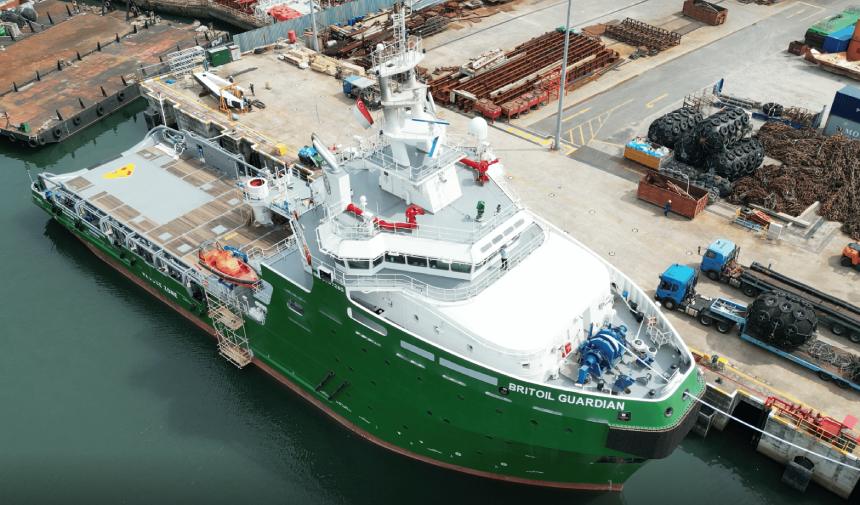
Vroon’s low-end, mainly Chinese-built fleet barely competes anywhere in the world with Tidewater, with only two vessels working in Morocco, which is not even in West Africa, Tidewater’s largest market, and one of those vessels goes to Golden Energy Offshore anyway. Britoil has placed a few vessels in the West African market itself, notably Britoil Guardian, a 2022-built, 100-tonne bollard pull DP2 anchor handler in Ivory Coast, and Britoil Destiny, a 90-tonne BP, 3,100DWT FIFI2 anchor handler, which it has deployed to Angola. Remember that West Africa is the jewel in Tidewater’s crown, accounting for 30 per cent of the company’s revenue in the second quarter, but 38 per cent of its operating income.
Vroon’s fleet consisted of six high-end PX121 PSVs, which most certainly do compete with Tidewater, but four of those go to Golden Energy Offshore and Britoil keeps just two. The other eleven PSVs that Britoil bought are lower specification, mainly Chinese-built PSVs of Khiam Chuan Marine (KCM) 80-metre design and with 750 square metres of clear deck space, along with two older Damen 7216 design units, two UT755-LN design ships, and two more KCM 75-metre vessels with 700 square metres of clear deck space.
Vroon’s 16 anchor handlers are mostly DP1 5,150bhp (3,840kW) vessels built in China, a segment that Tidewater largely exited in the downturn in its own “sale of the century.” Tidewater did acquire a few anchor handlers from Swire Pacific Offshore, but just five remain in its fleet today.
In Southeast Asia, the one PSV of the seven Vroon vessels acquired by Britoil in that region does compete with the two low-end Tidewater PSVs in the region, as per Tidewater’s first half-year results report. With only 14 vessels in the Asia-Pacific, the area has become largely irrelevant to Tidewater, and the company barely has a presence in Egypt or Italy, where Vroon is strong. The two will compete in the North Sea, but the sale of the Golden Energy Offshore PSVs means that Britoil will have only five PSVs in that market, whereas Tidewater operates around 50 PSVs in the North Sea, post Solstad acquisition.
X-Press what he’s got, oh-baby, ready or not!
The Vroon fleet should prosper alongside the Britoil fleet of 21 anchor handling tugs, four AHTS, and two PSVs, as there are definitely synergies in the Middle East, a market where one of Britoil’s main customers was just thrown a lifeline by its lenders. Unfortunately, it is also the lowest margin market and fiercely competitive.
With the container industry about to enter its worst recession for more than a decade, the Hartnoll family’s X-Press Feeders will likely need all the support that Britoil can provide from the booming offshore market.
According to industry sources, X-Press Feeders is the world’s largest independent feeder operator, with a fleet of 86 vessels, of which only 37 are owned, but it has an orderbook of 26 newbuilds in the feeder segment, with a total capacity of 90,162 TEUs. Many of these ships were ordered in China in 2021 at the market peak. In June, X-Press announced another newbuild order for six 1,250TEU dual-fueled feeder vessels, which it said were capable of operating on both methanol and conventional bunker fuel, and will most likely be deployed across its European network.
Britoil was purchased for a bargain price in 2021, and with the Vroon acquisition, it can provide a useful foil to the feeder business. That’s what diversification is all about.
Tidewater is in a league of its own

Tidewater’s market capitalisation of US$3.7 billion for a fleet of 187 vessels (including six in lay-up) on June 30, plus the 37 PSVs it bought from Solstad in a deal that closed in July, far exceeds that of any other OSV player. Tidewater has no peers in the industry and its valuation is now one of a kind. Its two largest rivals, Edison Chouest and Bourbon, have barely completed ugly reconstructions and are hamstrung by laid-up vessels, legacy contracts, and an obvious shortage of capital.
In the last month, Tidewater’s increase in market capitalisation, as its shares surged over US$71 per share, up 13 per cent, exceeded the value of the entire offshore business of Vroon. Tidewater’s total enterprise value now exceeds US$4.4 billion, as the company had US$180 million of long term debt on June 30, and then added a US$250 million Nordic bond issue and a US$325 million senior secured term loan from DNB Bank and other lenders to fund the Solstad purchase. This gives an average of US$20 million per vessel across its entire fleet, which has an average age of over 11 years.
This rise in Tidewater’s stock price has been fueled by the perception that its competitors are weak and badly managed, that there are few quality vessels left in lay-up or in shipyards in China that can add capacity, and that it can continue to raise prices without newbuilds being ordered to spoil the party.
We’ll examine those assumptions in a future piece.
ING Bank’s folly, Holland’s loss
The news that Britoil was buying the 30 vessels, along with the Vroon Offshore Services management offices in Genoa and Singapore, was accompanied by the sad news that the company’s Den Helder office in the Netherlands would be shut next year. The main reason for the closure of the Den Helder office was that Vroon’s banks failed to maintain discipline and decided to spin off nine of the company’s vessels separately, in a “disorderly dissolution” that we had warned of in February when the process began. This led to the North Sea fleet being too small to be viable as a separate business unit.
ING Bank’s decision to sell five ships to Golden Energy Offshore without a competitive auction is also inexplicable. We maintained at the time that the process was flawed. This was proven by the news that Golden Energy Offshore has managed to flip VOS Sugar for €15 million (US$15.9 million at current exchange rates). “When completed, [the sale] would represent a substantial cash profit to the company relative to the acquisition cost of US$9.4 million,” the company said in a stock exchange filing.
A profit of more than 60 per cent for holding an asset for a month is a disgrace to the original sellers. ING Bank proves once again that the restructuring departments of banks make terrible, terrible shipowners. To paraphrase Shakespeare in Macbeth, describing the execution of a traitorous thane, “Nothing in his life became him like the leaving it”. So too, ship-owning and ING Bank.
Last Saturday, Golden Energy Offshore stated that the total en bloc consideration of US$84.6 million for the four PX121 vessels is most “attractive relative to latest broker valuations” from Hagland and Seabrokers, which implied “a value of US$94 million.”
So, ING appears to have left more than US$15 million on the table. Great work, team!
Golden Energy Offshore’s sugar daddy
Golden Energy Offshore is the heir to Ugelstad Shipping, which was founded in 1928 and entered the offshore sector in 1974. The company has maintained a public listing in Oslo with a fleet of just three PSVs, two of them PX121 design, after it sold the UT755 design Energy Scout last year.
However, it has the backing of the powerful private credit and equity player Oaktree, a long-time player in the wider shipping industry. Oaktree backed Genco Shipping and Trading, a US-based operator of more than 50 dry bulk cargo vessels that went public in 2005. In 2010, it paid US$100 million for a majority stake in Gulmar, a Dubai-based operator of diving support vessels, which it renamed Harkand, and it invested €200 million (then worth US$280 million) in Beluga Shipping, a German operator of heavy-lift ships.
Oaktree is the majority owner of Golden Energy Offshore with 49.99 per cent of the shares in the company and also funded the acquisition of the Vroon vessels through its Fleetscape ship finance subsidiary. Fleetscape lent US$92 million for five years at a margin of 650 basis points over the Secured Overnight Financing Rate (SOFR, the successor to Libor). SOFR was 5.31 per cent on Friday, so Golden Energy Offshore is paying just under 12 per cent for its loan, along with an upfront fee of 1.6 per cent, another nice US$1 million bonus to someone. Oaktree is also major investor in ship manager OSM Thome, which provides crewing and technical management to Golden Energy Offshore.
As a listed company now operating seven modern large PSVs, Golden Energy Offshore provides an excellent vehicle for Oaktree, with flexibility to provide both equity financing and debt. As European banks increasingly withdraw from financing offshore assets, which are perceived to be dirty and polluting, we can expect more private players like Oaktree to enter the space.
The returns are just too high to ignore.
The US$410 million estimate
So how did I reach the US$410 million estimate? I should stress it is an estimate and if you wish to go on the record as one of the buyers, feel free to email the editor. We at Baird Maritime are always open to correction.
We believe that the two walk-to-work vessels are being touted at US$70 million together by Vroon’s banks, that Golden Energy Offshore paid US$94 million for its five ships, and that Rederij Groen paid US$7 million for its two seismic chase vessels from the 5,150bhp AHTS fleet. That’s a subtotal of US$171 million.
I reckon – finger in the air, strictly without guarantee – that Britoil paid in the region of US$239 million for its 29 meaningful vessels with their contracts and the support of the highly-regarded shore teams. We assign nil value to the tiny 385DWT VOS Tramontana. We reckon the two PX121s went for US$42 million, on a par with the Golden Energy Offshore price, that the four 80 tonnes BP AHTS were priced at US$7 million each (total US$28 million), the remaining ten 5,150hp vessels at US$3 million each average (total US$30 million), depending on their docking statuses, the two other subsea vessels (VOS Sugar and VOS Star) at US$20 million total, and the remaining eleven PSVs probably went for an average price of just under US$11 million each, with the modern KCM 80-metre units fetching maybe US$15 million apiece, and the older Damen and UT755Ls going for higher single digits, and the two KCM 75-metre units VOS Prudence and VOS Purpose, close to the average.
With Britoil finally sold, that leaves (checks notes) closure for the Bourbon, DOF, and Solstad fleets, which all have what can politely be described as “lender shareholder profiles”, and for a couple of private equity exits. We’ll keep you posted.
With Tidewater’s competitors in disarray and distracted, the company can rest easy for now.
Background Reading
Oaktrees’s diverse portfolio of European investments is here. The company is also an investor in Hafnia Tankers and OSM Thome, and its quarterly market commentary here.
Golden Energy Offshore’s latest presentation is very bullish in the PSV market. It has to be, right?
Why not relax with the video for Express Yourself?


